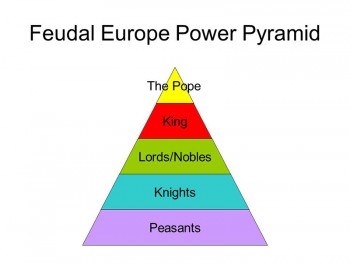Feudalism, in a stricter sense, represents a system of rights and obligations that is founded on the ownership of land, and the personal relations in which the vassals hold fiefs (land) that is granted by their lord (senior).
In a broader sense, this term encompasses “feudal society”, as a system of economic, social and political organization that is founded on the relationship of individuals, in which one class of specialized warriors – feudal lords – which are ranked in a strict hierarchy of intertwined dependencies, rules over a mass of peasants who work the land and provide for their living.
The “feudal society” mostly developed in a autarchic (independent) agricultural economy, this way of development is characteristic for societies such as these, where agriculture is the dominant branch of economic gain.
The development of European feudalism begins in the 8th century, the time of the first Merovingians and Carolingians, with the interconnection of the granting of fiefs and the establishing of personal vassal-senior relations. The Vassal is a freeman who is willingly engaging in a personal relationship with another freeman, the senior. The senior and the vassal are connected by a vassal agreement. According to this agreement, the vassal is obligated to consilium – attending the meeting which the senior calls, and auxilium – which is aid (financial or military). In return, the senior is obligated to aid the vassal.
Governing usually has two bearers: The sovereign owner (the one who has conquered the land and has no immediate connection with the land itself) and the user (the one who is working the land – the vassal). Also, there are two types of land: Alodial (land which the feudal lord keeps for himself, and which his own serfs work), and the land which the feudal lord grants to his serfs for their own needs. The serfs are obligated to pay feudal rent for the land that they have been granted in three basic forms: working their master’s land, resource rent (agricultural products) or financial rent.
Feudalism can be visualized in the form of a pyramid: the uppermost spot is occupied by the major sovereign (major senior, that is, the king), below are the vassals who, in turn, have their own vassals. This hierarchy is continued towards the bottom, and the higher vassal is a senior to the lower vassal. The whole feudal hierarchy is based on the serfs as basic producers.
Villages
The basic production unit in the medieval society was the village, that is the village municipality, and not the fief. Villages were producing enough food for their own needs, but in times of war and epidemics even this was not possible.
All farmable land was divided into a few open fields, and every peasant was working a part of these fields on his land. The feudal lord had his own track of land on every field, the peasant had the same. Fertilizers didn’t exist for the most part, and the deficiency in livestock denied any proper toiling of the land. The only way to prevent exhaustion of the land was leaving the fields to fallow. In the northern parts of Europe the three fields system was gradually developed. Since basic knowledge of hygiene was missing, the wells were contaminated, and even contaminated water was used as drinking water. Many were discontent if they were not given their daily dose of beer or wine. In years of famine and starvation, the production of beer was prohibited to save crops, but this was sometimes hard to implement.
Villages were not only maintaining peasants, but the higher classes also, which were tasked with the spiritual and political prosperity of the village. During the reign of the Carolingians, the church tithe was mandatory; every peasant had to give 10% of his earnings in agricultural goods and livestock. It was often the case that the senior took over the right of collecting the whole, or parts of the tithe, which was supposed to go to a certain parish, and this could be granted to one of his vassals as a fief.



The peasants were obligated to work the land of the senior and to take care of his livestock. Since the senior was the de facto ruler of all the land in the village, the peasant had to pay the owner for his house and the land he toiled. The amount of taxation depended on the status of the peasant.
Apart of the taxation of land, the lord could ask for a part of the eventual gain the peasant had on the market, or for a part of his property. Freeman were usually exempt, but not always, but dependent and half-dependent people were forced to pay high percentages.
The feudal lord had some monopolies in the village. He had the mill, the oven, and usually, in the southern regions, a wine press. It has to be said that the rents which the feudal lords collected were mostly agricultural products; such was the situation in the majority of Europe. It was possible for a village to have multiple lords. Rights of inheritance, and deliberate actions of the major sovereign could lead to partitioning of the land and multiple owners.
In some regions, usually in the southern part of the continent, there will still small, independent fiefs. There were certain regions where people lived in small villages that were self-sufficient.
[wpdevart_youtube]uv4ad3mEDR0[/wpdevart_youtube]
